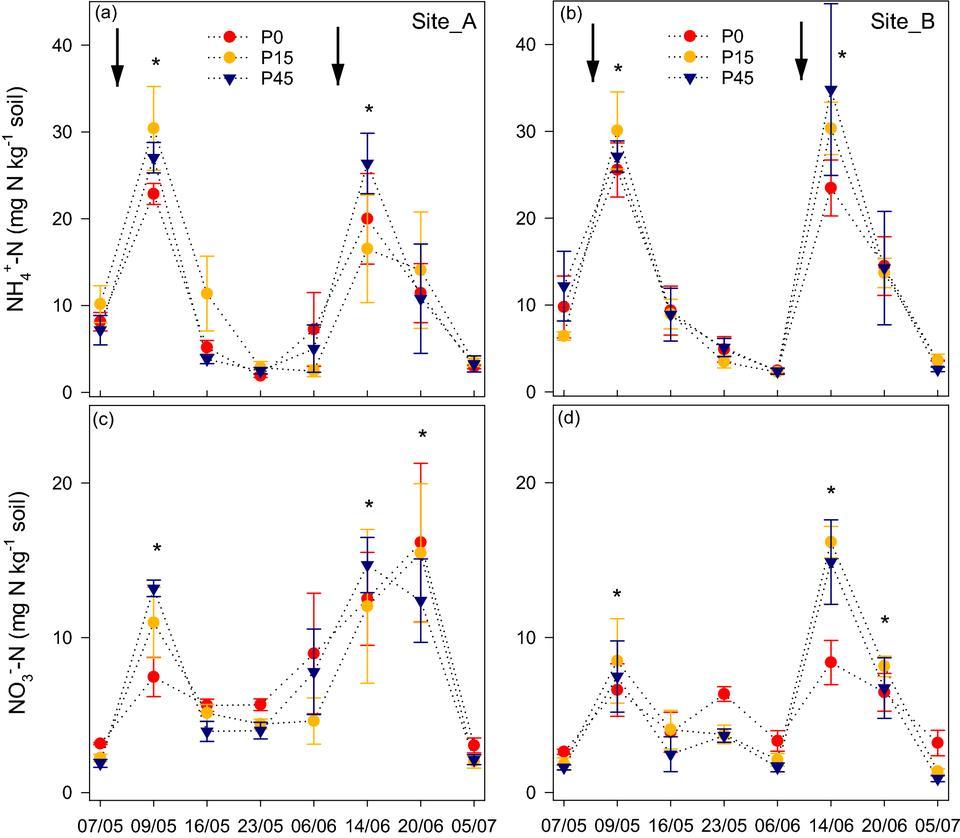Nitrous oxide (N2O) and carbon dioxide (CO2) are two of the main greenhouse gases (GHGs) emitted from agricultural soils. Nitrous oxide is a potent GHG with 298 times more global warming potential than CO2 and arises from application of organic and inorganic nitrogen to soil1. Further, carbon dioxide emitted from soil auto- and heterotrophic respiration represents an important flux component in the global carbon cycle between soil and the atmosphere2. Grasslands constitute one of the dominant land uses in Europe, comprising 38% of agricultural land, and grassland management practices substantially contribute to GHG emissions3,4. Owing to their large capacity for storing soil organic carbon (SOC), grasslands play a significant role in mitigating climate change5. Intensively farmed grassland soils are routinely supplemented with nutrient inputs, such as nitrogen (N) and phosphorus (P), to increase herbage biomass production, as these nutrients support plant photosynthesis, protein synthesis, and energy transfer. Despite their importance, imbalanced use or availability of N and P may induce significant alterations in ecosystem structure and functioning, and thereby dynamics of carbon (C) and nitrogen cycles6.

Long term and repeated fertilizer applications affect the C:N:P ratio and the cycling of these nutrient in agricultural soils through changes in microbial biomass and community composition7,8,9,10. Phosphorus and nitrogen fertilization have been found to impact mycorrhizal community and biomass7,11, plant species richness and diversity12 as well as root exudation and turnover13, all of which could influence C movement and plant–soil nutrient relations in ecosystems. Microorganisms can obtain C from organic material and mineralise it into simpler inorganic compounds to release essential nutrients, whose availability in soil limit successful plant and microbial growth. The availability of N and P relative to C (stoichiometric relationships) determines microbial mineralization or immobilization of these nutrients14,15 and may strongly affect C dynamics in an ecosystem. Studies suggest strong limitations of N and P on heterotrophic respiration indicating tight coupling of essential nutrients and carbon16,17,18. Nitrous oxide is primarily produced through microbial nitrification and denitrification, and its production via these pathways are affected by microbial composition as well as the availability of soil mineral N and phosphate, C substrate, oxygen, soil moisture, pH, and soil temperature17,19. While it is known that N fertilizer applications contribute to the formation of N2O4, there is a poor understanding of the interaction between soil nutrients and carbon availability, and their subsequent impact on N2O and CO2 emissions in agricultural soils.
Fertilizer-driven changes in managed grassland soils could have functional implications for the composition of arbuscular mycorrhizal fungi (AMF) and alter their symbiotic relationship with plants15,20,21,22. This symbiotic relationship comprises of increased access to N and P facilitated by the AMF to the plant in return for C11,23. However, the extent to which N, P and C is exchanged could be influenced by an increasing use of N and P fertilizers. In a P-rich soil, N enrichment has been found to cause reduced allocation of photosynthates to mycorrhizae arbuscules, coils and extraradical hyphae23. In contrast, nitrogen enrichment of low P soils increased C allocations to these structures23. Thus, the availability of N relative to P in mycorrhizal system could affect the relationship between fungi and hosting plants and limit the ability of fungi to procure the elements. Lower P levels were associated with a significant increase of AMF colonization in a study conducted in the same experimental field of the current investigation24. Contrasting presence of AMF in agricultural soils could have major implications for variable N2O and CO2 formation and may result in different nutrient use of efficiency of plants. Bender et al.25 and Storer et al.26 showed reduced N2O emissions in soils with abundant presence of fungi group, AMF, despite fungi are generally considered as a source of N2O as they lack N2O reductase27. In contrast to these findings, Okiobe et al.28 demonstrated promoted potential N2O production as a result of decreased abundance of arbuscular mycorrhizal fungi. In a recent laboratory-based study, significantly higher N2O emission was observed in a P-limited soil than in a P-enriched soil following the same input of C and N in the two varying P-levels29. However, this relationship requires further investigation and verification under natural field conditions with plants present. Here we investigate the influence of N fertilizer addition and C availability on N2O and CO2 emissions across two agricultural soils with sandy loam (Site A) and loam (Site B) textures with differing soil P levels in each soil30. We hypothesized that the largest magnitude of N2O release occurs at low soil P levels in grassland soils. We further hypothesized that CO2 production increases with increasing levels of P in these soils. The main objective was to understand how N2O and CO2 emissions are affected in response to C + N additions across a soil P gradient.
